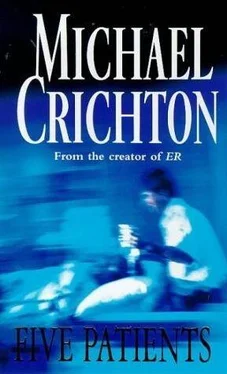Michael Crichton - Five Patients
Здесь есть возможность читать онлайн «Michael Crichton - Five Patients» весь текст электронной книги совершенно бесплатно (целиком полную версию без сокращений). В некоторых случаях можно слушать аудио, скачать через торрент в формате fb2 и присутствует краткое содержание. Жанр: Триллер, на английском языке. Описание произведения, (предисловие) а так же отзывы посетителей доступны на портале библиотеки ЛибКат.
- Название:Five Patients
- Автор:
- Жанр:
- Год:неизвестен
- ISBN:нет данных
- Рейтинг книги:5 / 5. Голосов: 1
-
Избранное:Добавить в избранное
- Отзывы:
-
Ваша оценка:
- 100
- 1
- 2
- 3
- 4
- 5
Five Patients: краткое содержание, описание и аннотация
Предлагаем к чтению аннотацию, описание, краткое содержание или предисловие (зависит от того, что написал сам автор книги «Five Patients»). Если вы не нашли необходимую информацию о книге — напишите в комментариях, мы постараемся отыскать её.
Five Patients — читать онлайн бесплатно полную книгу (весь текст) целиком
Ниже представлен текст книги, разбитый по страницам. Система сохранения места последней прочитанной страницы, позволяет с удобством читать онлайн бесплатно книгу «Five Patients», без необходимости каждый раз заново искать на чём Вы остановились. Поставьте закладку, и сможете в любой момент перейти на страницу, на которой закончили чтение.
Интервал:
Закладка:
The student's formal discussion is known as "presenting." To present a patient means to deliver the salient information in a brief, highly stylized form. The student is expected to do this from memory. A presentation begins with events leading up to admission for the present illness; then goes on to past medical history; then a review of organ systems; family and social history; physical findings beginning at the head and working down to the feet. Laboratory data is then presented in a specific order: blood studies, urine studies, cardiogram, X rays, and finally more specialized tests.
The entire process is not supposed to take more than five minutes.
A good presentation is difficult, for along with summarizing positive findings, the student is expected to include certain "pertinent negatives" from among the almost infinite number of symptoms and signs the patient does not have. These pertinent negatives are intended to exclude specific diagnoses. Thus, if a patient has jaundice and a large liver, the student should state that the patient does not drink, if this is the case.
Aggressive students can be quite abstruse in their negatives, hoping that the instructor will interrupt and ask (for example): "What were you thinking when you said the patient had never danced in Tibet?"
To this the student can triumphantly name some obscure disease that vaguely fits the situation, such as "the Kurelu Dancing Syndrome, sir." He thus appears well read. The game can be dangerous with a knowledgeable visit, however, for he is likely to shoot back: "The Kurelu Dancing Syndrome never occurs in males under forty, and your patient is thirty-six. If you want to do some reading, I refer you to the Kurelu Medical Journal, volume ten, number two." This is a signal for the student to crumble; he has lost the round-unless, of course, he has a rejoinder. There is only one acceptable form: "But, sir, in the Mauritanian Journal of Midwifery last week there was a report of a case in a ten-year-old boy." This may, or may not, work. The visit may reply, "The what journal? Wasn't that the one which reported that skimmed milk caused cancer?"
That ends the discussion.
Among students, visits are classified into two groups-"benign," and the others. It depends on how the visits treat students. Generally the visit sits in silence throughout the presentation; he then begins by pointing out all the things the student forgot to mention; and then proceeds to ask questions. He is entitled to ask questions on anything he likes, so long as it vaguely relates to the case at hand. He can, if he wishes, keep the student hopping.
For example, a typical discussion about a case of stress duodenal ulcer might have the visit first asking the anatomy of the four parts of the duodenum; then the arterial supply to the stomach; the common complications of duodenal ulcer; the factors that classically increase and decrease ulcer pain; the features that distinguish ulcer pain from the pain of acute pancreatitis, gall bladder disease, or heart attack; the four indications for surgical intervention; the reasons for measuring serum pancreatic amylase and serum calcium; the mental changes one might expect with GI bleeding in the presence of liver disease, and the reason for the change; the other causes of upper GI bleeding; the way to distinguish upper and lower GI bleeding; and so on.
Furthermore, the visit can shift to a related topic at any point. If he asks about serum calcium and the student correctly answers that there is a relation between parathyroid disease and ulcer, the visit may go on to ask how calcium fluctuates in parathyroid disease; the associated changes in serum phosphate; what changes might be seen in the electrocardiogram; what mental changes are associated with increased and decreased serum calcium, in adults and in children.
Thus a student who began talking about ulcer disease is effectively shunted to calcium metabolism. And, at any time, the visit can turn around, demand to know six other conditions associated with ulcer, [Such as chronic lung disease, cirrhosis, rheumatoid arthritis, burns and strokes, pancreatitis, and the effects of certain drug therapies, especially steroids] and go on to discuss each of them. Visit rounds are two hours long. There is plenty of time.
For the most part, interns and residents are exempt from grilling; it is considered too undignified. The visit treats house officers as colleagues, but not students. A house officer who asks a question of the visit will get an answer. A student who asks a question will most often get a question back, as in "Sir, what does the serum calcium do in Chicken Little disease?" "Well, what do the plasma proteins do in Ridinghood's Macro-globulinemia?" If the student fails to see the light, he will get another hint, also in the form of a question: "Well, then, what about the serum phosphate in Heavyweight's Syndrome?"
This is a form of a game which is repeated over and over again in medical teaching. It is a game useful to the conduct of medical practice. A very simple example of the game is the following:
student: "The patient has a rash and fever."
visit: "Has he ever been to Martha's Vineyard?"
student: "No, he does not have Rocky Mountain spotted fever."
The point is that the student sees the implication behind the question-that each year one or two cases of Rocky Mountain spotted fever are contracted on Martha's Vineyard. Such deductive processes are precisely those important to the conduct of medicine, and therefore represent a useful teaching method. In the extreme, this can lead to a leap-frog interchange which is almost beyond the understanding of the casual observer:
student: "The patient has kidney disease consistent with glomerulonephritis."
visit: "Was there a recent history of infection?"
student: "Anti-streptolysin liters were low."
visit: "Was there a facial rash?"
student: "LE prep and anti-nuclear antibodies were negative."
visit: "Were there eyeground changes?"
student: "Glucose-tolerance test was normal."
visit: "Did you consider rectal biopsy?"
student: "The tongue was not enlarged."
This is jumping from mountaintop to mountain-top, skipping the valleys. In translation, the visit is asking, first, whether the glomerulonephritis was caused by streptococcal infection; second, whether it is due to lupus; third, to diabetes; and finally, whether due to amyloidosis. The student is denying each diagnosis by presenting negative data. Neither teacher nor student specifies the diagnosis; the game is to figure out what each is talking about without saying what it is.
This Socratic tradition of teaching medical students dates back to the days when medicine was an apprenticeship in the strictest sense. The Socratic method has the virtue of informality: on work rounds, the resident can ask the student in passing, "How will we know when Mr. Jones is adequately digitalized?" and the surgeon can pause in his operation to ask the student, "What would happen if I cut this nerve here?" It is a good way to keep the student constantly recirculating his knowledge through his brain, and by and large it works well.
Why not just state the fact, as a declarative statement, for the edification of the student? There is just one major reason: most medical students are tired. At any given moment, a lecture to a medical student is a signal to click off, to tune out, to go to sleep. Partly, this is a learned response. It is common, during the first two years of medical school, to have four hours of lectures and five hours of laboratory work in a single day. Students who are studying late into the night on top of this schedule learn to sleep during lectures with great facility. The pattern carries on into the clinical years. One can observe lectures to medical students and house staff in the hospital in which 20 to 50 per cent of the class is slumped over in their chairs. The lecturer pays no attention. To a lecturer, it is not an insult, but a fact of life. Everybody accepts it; everybody expects it.
Читать дальшеИнтервал:
Закладка:
Похожие книги на «Five Patients»
Представляем Вашему вниманию похожие книги на «Five Patients» списком для выбора. Мы отобрали схожую по названию и смыслу литературу в надежде предоставить читателям больше вариантов отыскать новые, интересные, ещё непрочитанные произведения.
Обсуждение, отзывы о книге «Five Patients» и просто собственные мнения читателей. Оставьте ваши комментарии, напишите, что Вы думаете о произведении, его смысле или главных героях. Укажите что конкретно понравилось, а что нет, и почему Вы так считаете.









